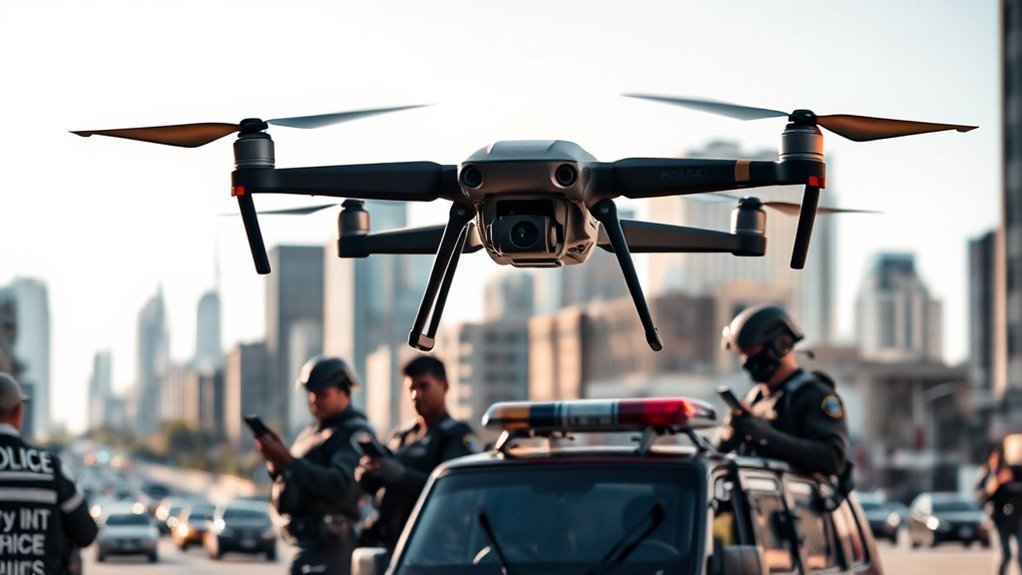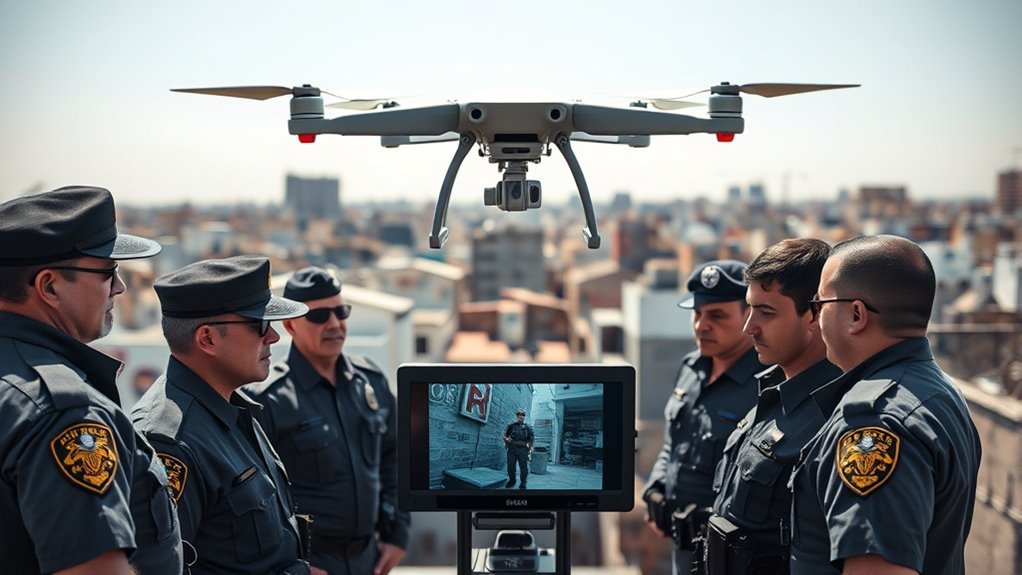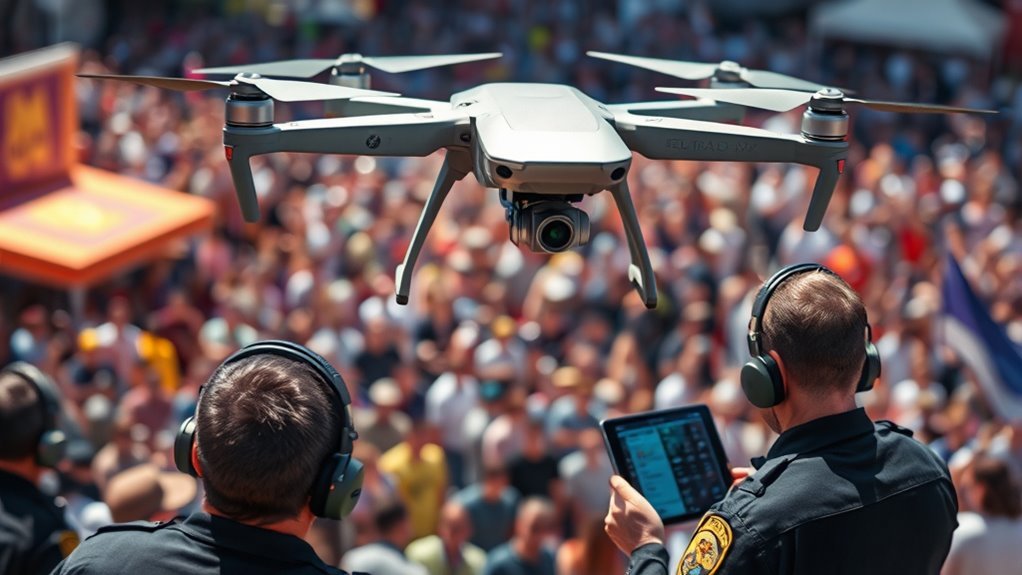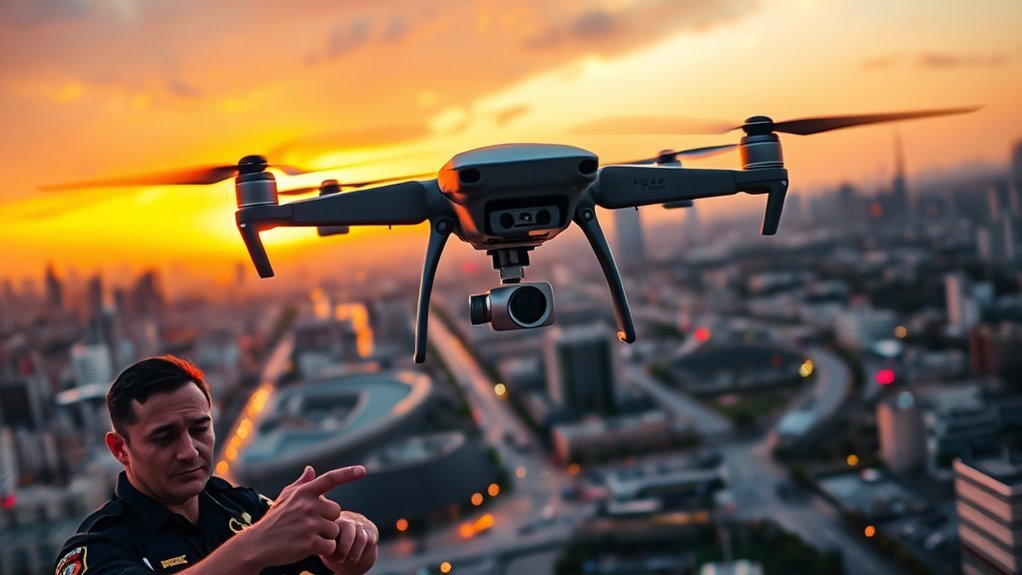Cops use drones for various roles in modern policing, including surveillance, search and rescue, crowd control, and traffic accident investigations. These unmanned aerial vehicles offer real-time data and enhance situational awareness during emergencies. While drones can improve public safety, they also raise significant privacy concerns among citizens. The balance between security and personal freedoms is vital, and the discussion around ethical data use continues to evolve. There’s more to uncover about the implications and future of drone technology in policing.
Surveillance and Monitoring

As police departments increasingly turn to drones for surveillance and monitoring, concerns about privacy and civil liberties emerge. You may find it unsettling that these unmanned aerial vehicles can capture video and images without your knowledge. While proponents argue that drones enhance public safety, they often overlook significant privacy concerns. The potential for abuse grows as law enforcement gains access to vast amounts of data, creating a surveillance state that many fight against. Additionally, technological limitations, such as data storage and processing, can lead to misinterpretation or misuse of information. Balancing security needs with personal freedoms is essential, and as technology evolves, it’s imperative for you to stay informed and advocate for policies that protect your rights in this digital age.
Search and Rescue Operations

In recent years, police departments have deployed drones in search and rescue operations with remarkable success, greatly enhancing their ability to locate missing individuals quickly and efficiently. Drones technology allows for real-time aerial views, making it easier for emergency coordination teams to assess situations from above. The combination of thermal imaging and high-resolution cameras empowers responders to cover vast areas in less time than traditional methods. Additionally, the use of advanced monitoring systems ensures that search efforts can be optimized based on real-time data analytics, improving overall effectiveness. Furthermore, the integration of real-time data processing capabilities enables teams to make swift adjustments during ongoing operations.
| Feature | Advantage | Impact |
|---|---|---|
| Aerial Coverage | Broad view of terrain | Faster identification of subjects |
| Thermal Imaging | Detects body heat | Locate people in dense areas |
| Real-Time Data | Instant communication | Improved decision-making |
| Cost-Effective | Less manpower needed | Efficient resource allocation |
Crowd Control at Large Events

While large events can bring communities together, they also pose significant challenges for maintaining safety and order. Drones have emerged as essential tools in managing these situations effectively. Their use enhances event safety and boosts public awareness. Here’s how they assist:
- Real-time Surveillance: Drones provide a bird’s-eye view, allowing law enforcement to monitor crowd dynamics and detect potential issues before they escalate.
- Rapid Response: In emergencies, drones can quickly deliver information to officers on the ground, facilitating swift interventions.
- Communication Support: Equipped with speakers, drones can relay important messages to the crowd, ensuring everyone remains informed and calm.
Traffic Accident Investigation
Drones are revolutionizing traffic accident investigations, offering a level of detail and efficiency previously unattainable. By capturing aerial footage, they provide an extensive view of the accident scene, essential for accurate collision reconstruction. You can see how drones allow law enforcement to gather data from various angles, revealing critical evidence that might be overlooked at ground level. This high-resolution imagery aids in incident documentation, making it easier to analyze the circumstances leading to the crash. Drones can assess damage and measure distances with precise accuracy, streamlining the investigative process. Ultimately, this technology not only speeds up investigations but also enhances transparency, empowering communities with the knowledge of how accidents unfold and the necessary steps to prevent them in the future.
Drug and Crime Scene Analysis
As technology advances, the application of drones in drug and crime scene analysis is proving to be transformative. Drones offer law enforcement a unique vantage point for tackling drug trafficking and enhancing forensic analysis. Their capabilities can markedly improve investigations through:
- Real-time surveillance: Drones can monitor suspected drug trafficking routes and gather vital data without needing boots on the ground.
- Aerial mapping: They create detailed maps of crime scenes, allowing investigators to analyze spatial relationships and gather evidence more efficiently.
- Evidence collection: Drones can access hard-to-reach areas, enabling the retrieval of physical evidence that might otherwise go unnoticed. Additionally, the integration of real-time data collection ensures that law enforcement can respond swiftly to evolving situations on the ground.
Aerial Photography for Evidence Collection
Although traditional methods of evidence collection have their merits, aerial photography greatly enhances the capabilities of law enforcement agencies. With drones equipped for aerial mapping, officers can gather extensive, high-resolution images of crime scenes from various angles, providing a thorough view that ground-level photos can’t match. This method improves evidence documentation, allowing for meticulous analysis and clearer presentation in court. By capturing large areas quickly, aerial photography not only saves time but also helps in reconstructing events with precision. Furthermore, it can reveal details that might go unnoticed from the ground, supporting investigations with a broader context. As you consider the implications, it’s clear that embracing such technology can elevate the efficiency and accuracy of modern policing practices.
Community Engagement and Transparency
As police departments increasingly adopt drone technology, the importance of community engagement and transparency becomes essential. You might wonder how real-time information sharing can enhance public trust and foster collaboration between law enforcement and citizens. Examining these dynamics reveals the potential for drones to not only aid in policing but also to bridge gaps between communities and their police forces.
Enhancing Public Trust
When police departments integrate drones into their operations, the potential for enhancing public trust hinges on effective community engagement and transparency. To foster a positive public perception, consider these key strategies:
- Open Communication: Share information on how drones support community safety, ensuring citizens understand their purpose and function.
- Community Involvement: Involve local residents in discussions about drone usage, addressing concerns and gathering feedback to build rapport and trust.
- Transparency in Operations: Make drone policies accessible to the public, detailing usage guidelines and data collection practices to alleviate fears of surveillance.
Real-Time Information Sharing
Integrating drones into policing not only enhances public trust but also opens avenues for real-time information sharing, a vital component of community engagement. By utilizing advanced drone technology, law enforcement agencies can gather and disseminate data with remarkable information accuracy. This capability allows officers to respond swiftly to incidents, keeping communities informed in real-time.
Moreover, data integration from drones can provide a thorough view of ongoing situations, facilitating better decision-making. When communities see law enforcement actively sharing information, it fosters transparency and encourages collaboration.
However, it’s important to balance this technological advantage with privacy concerns. Engaging the public in discussions about how data is collected and used guarantees that citizens feel empowered rather than surveilled, nurturing a more harmonious relationship.
Frequently Asked Questions
Are There Privacy Concerns Regarding Police Drone Usage?
Oh, sure, let’s just have drones zipping around, right? But seriously, you’ve got to wonder about civil liberties and how public perception shifts. Are we trading freedom for surveillance? A slippery slope, indeed.
How Are Drones Maintained and Operated by Police Departments?
Drones require meticulous maintenance and skilled pilots. You should know that police departments invest in regular drone maintenance schedules and thorough pilot training programs, ensuring efficiency and safety while addressing potential community concerns about surveillance practices.
What Types of Drones Are Commonly Used in Policing?
Imagine a watchful hawk soaring high. Police commonly use drones with advanced surveillance capabilities, like quadcopters and fixed-wing models, providing essential aerial support for crowd monitoring, search operations, and crime scene assessment, enhancing public safety effectively.
How Do Police Ensure Drones Are Used Ethically?
To guarantee drones are used ethically, police must adhere to strict ethical guidelines and involve community oversight. This transparency fosters trust, safeguarding individual freedoms while balancing public safety in an increasingly surveillance-driven society.
What Regulations Govern the Use of Drones by Law Enforcement?
When exploring regulations governing drone use, you’ll find drone legislation varies by state, often shaped by law enforcement policies. It’s essential to understand how these rules impact your privacy and civil liberties in today’s society.

